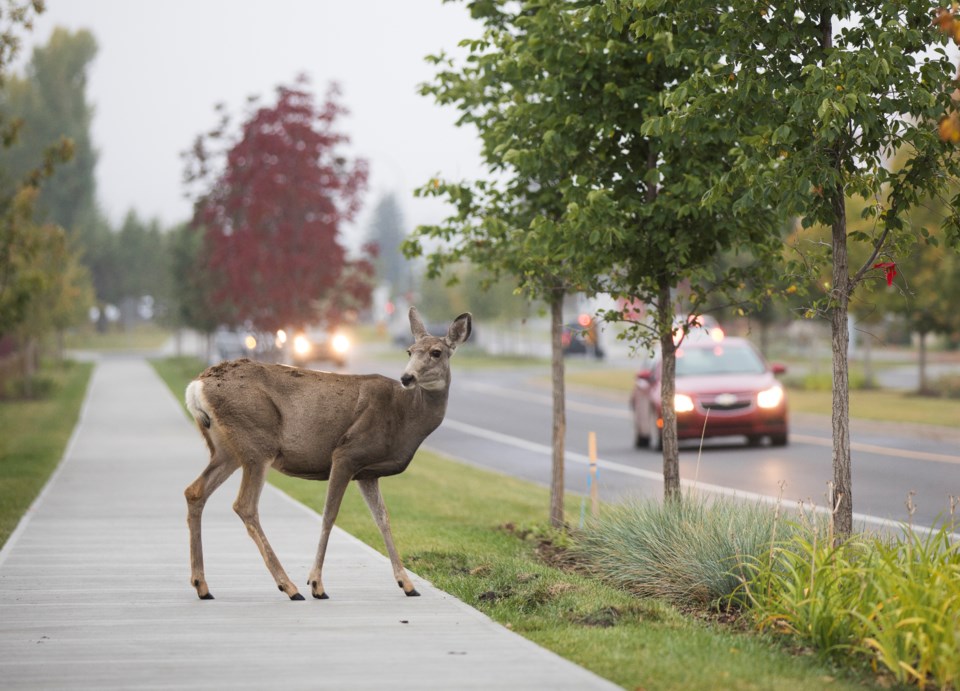Members of the Okotoks Urban Deer Task Force are busy compiling data and potential solutions to common complaints and issues as they prepare to bring forward their strategy report in 2021.
“Things are moving along, we’re fleshing out our draft report more and more, getting a few more of the holes filled in, identifying a lot more issues and potential solutions or ideas for solutions to discuss,” said Grant Pryznyk, chair of the task force.
He said a deer count was completed Sept. 22 and 23, with a total of 51 counted within Town borders, compared with 108 counted in January.
There are a few reasonable explanations for the variance, he said, including the time of day counts were done and the possibility of some deer feeding in surrounding fields rather than in town given the time of year.
“Also with all the foliage and everything, sometimes you can walk right by a deer and unless they flick an ear or a tail or something you don’t even see them,” said Pryznyk.
With lower numbers of deer seen in town over the summer and fall, he began wondering whether the problem was subsiding, but the deer seem to be returning to the urban area.
Pryznyk said he saw 13 deer in the field west of the cemetery recently.
“There was a good mix of bucks in those, some of the biggest mule bucks I’ve ever seen, so we’ve got a healthy population back again,” he said.
With that in mind, the task force continues to compile information from scientific studies, experiences from other municipalities that have dealt with urban deer issues, and guest speakers and experts who attend or tune into meetings and share their findings.
In October, Liz White of the Animal Alliance of Canada joined the task force meetings to present information from a report the alliance wrote after working with several B.C. communities that had undertaken various types of deer control.
“They came up with some good recommendations on what works, what doesn’t work, what starts working then doesn’t work,” said Pryznyk.
The task force continues to consider and research all methods of population control, including culling, translocation, reproduction control and potential bylaws and policies, he said.
Culling was done by one community in the alliance’s report, but not for long. Some people had agreed to have traps on their properties but changed their minds when they saw how the deer were handled, he said.
“We still have to talk about it and examine all the pros and cons,” said Pryznyk. “We’re not going to toss anything because it seemed unpopular in other communities.”
At its November meeting, he said the task force members will hear from Town staff about fencing and landscaping materials such as trees and shrubs that are deer-resistant that Okotoks parks and residents could plant to deter the animals from public spaces and private yards.
Fencing is one of the issues brought up regularly by the public, he said. People have submitted comments to the Town about deer jumping over their fences, but they cannot be built taller.
“So what can we do to keep the deer from jumping over the fence?” said Pryznyk. “It’s either keep the fences as they are and remove food sources from the yard, or build the fences up – or a combination of the two.”
As complaints or concerns about deer are filed with the Town, they are forwarded to the Urban Deer Task Force, which makes note of the issue.
Beyond those submissions, public participation and feedback has been done via surveys in the past, typically around the times deer counts are completed. The last one was in 2018, said Joan Botkin, communications manager for the Town.
She said once the task force’s report is completed, it will be presented to the community for further feedback.
“To a certain degree the task force itself is public participation and represents a diverse amount of experts and community members and opinions,” said Botkin. “We already are doing public participation via the task force, but there is also an opportunity to further engage the community once they come forward with their strategy.”




